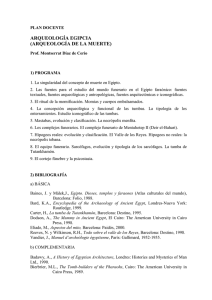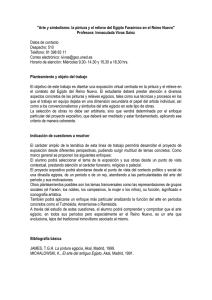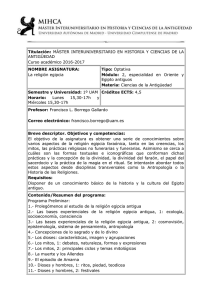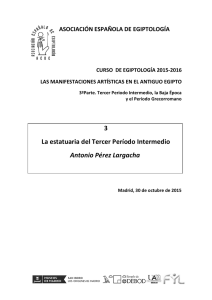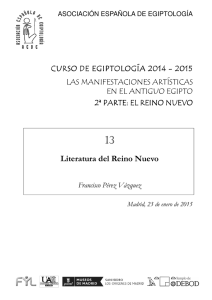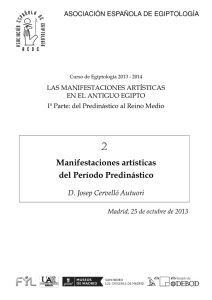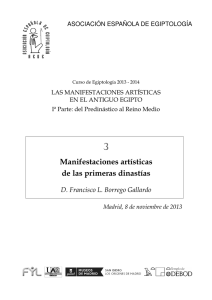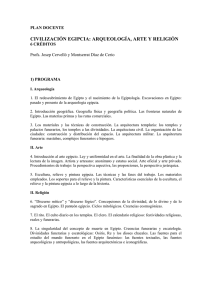Universidad Católica Argentina “Santa María de los Buenos Aires
Anuncio
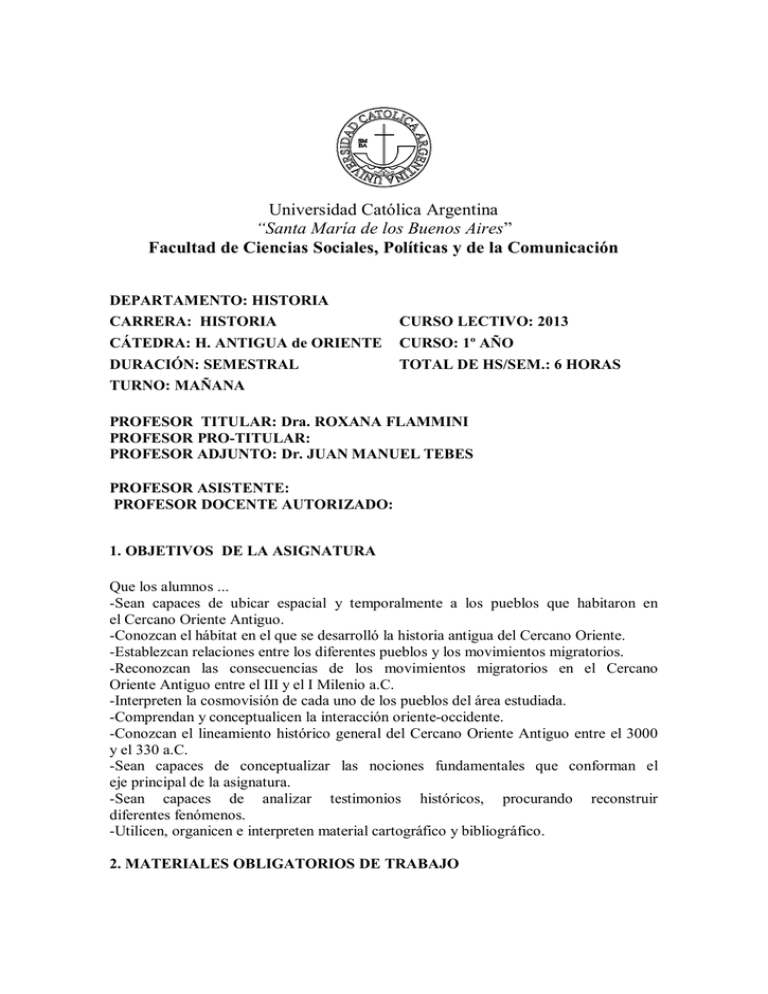
Universidad Católica Argentina “Santa María de los Buenos Aires” Facultad de Ciencias Sociales, Políticas y de la Comunicación DEPARTAMENTO: HISTORIA CARRERA: HISTORIA CÁTEDRA: H. ANTIGUA de ORIENTE DURACIÓN: SEMESTRAL TURNO: MAÑANA CURSO LECTIVO: 2013 CURSO: 1º AÑO TOTAL DE HS/SEM.: 6 HORAS PROFESOR TITULAR: Dra. ROXANA FLAMMINI PROFESOR PRO-TITULAR: PROFESOR ADJUNTO: Dr. JUAN MANUEL TEBES PROFESOR ASISTENTE: PROFESOR DOCENTE AUTORIZADO: 1. OBJETIVOS DE LA ASIGNATURA Que los alumnos ... -Sean capaces de ubicar espacial y temporalmente a los pueblos que habitaron en el Cercano Oriente Antiguo. -Conozcan el hábitat en el que se desarrolló la historia antigua del Cercano Oriente. -Establezcan relaciones entre los diferentes pueblos y los movimientos migratorios. -Reconozcan las consecuencias de los movimientos migratorios en el Cercano Oriente Antiguo entre el III y el I Milenio a.C. -Interpreten la cosmovisión de cada uno de los pueblos del área estudiada. -Comprendan y conceptualicen la interacción oriente-occidente. -Conozcan el lineamiento histórico general del Cercano Oriente Antiguo entre el 3000 y el 330 a.C. -Sean capaces de conceptualizar las nociones fundamentales que conforman el eje principal de la asignatura. -Sean capaces de analizar testimonios históricos, procurando reconstruir diferentes fenómenos. -Utilicen, organicen e interpreten material cartográfico y bibliográfico. 2. MATERIALES OBLIGATORIOS DE TRABAJO -Cuadernillo de Mapas (F, HAO1) -Guías Didácticas (CD; F, HAO) 3. UNIDADES TEMÁTICAS: se presentan 5 unidades temáticas. UNIDAD I: “Formación del Medio Oriente moderno e historiografía occidental” (Puntos 1.2, 1.3 y 1.4 Prof. Flammini; 1.1, 1.5 y 1.6 Prof. Tebes) 1.1. El Medio Oriente en la actualidad: independencia de los estados árabes e Israel. El conflicto árabe-israelí. 1.2. El Antiguo Oriente en la historiografía: La visión de los clásicos. Occidente “descubre” a Oriente: Napoleón en Egipto. La Ilustración y el siglo XIX: positivismo, evolucionismo, materialismo histórico. El siglo XX: escuela de Annales, neoevolucionismo. Nueva perspectivas historiográficas en el siglo XXI. 1.3. Cosmovisiones: Las sociedades antiguas y el hombre actual. Variaciones y semejanzas. Pensamiento integrado y pensamiento lógico. Niveles de interpretación. Las ideas. Los medios de la expresión cosmológica: literatura, estatuaria, monumentos. 1.4. Organización social: sociedades segmentarias y de jefatura. El parentesco. El Estado: la institucionalización del poder. Ciudad-estado, reino, confederación e imperio: discusión de terminología. Economía: escuelas en antropología económica. Formas de integración de la economía en sociedades no monetarias: reciprocidad, redistribución e intercambio. Redes de intercambio. Teoría del sistema-mundo aplicada a la antigüedad, centro- periferia. El hábitat: áreas centrales y periféricas. Variables económicas y sociales. 1.5. La dinámica social. Relaciones y conflictos. Nomadismo, sedentarismo. 1.6. Los pueblos y las lenguas: clasificación lingüística y movimientos migratorios. BIBLIOGRAFÍA OBLIGATORIA Nota: La Cátedra se reserva el derecho de modificar la bibliografía de acuerdo con criterios de actualización. El material traducido es de uso exclusivo de los alumnos de la Cátedra. BEININ, J, y HAJJAR, L., “Palestina, Israel y el conflicto árabe-israelí. Un compendio”. Middle East Research & Information Center. Traducción. (F, HAO) CERVELLÓ AUTUORI, J.1996. “Egipto, África y la Historia”, en: Egipto y África. Origen de la civilización y la monarquía faraónicas en su contexto africano, Barcelona, AUSA. (F, CEHAO) MARX, E., “Hay nómadas pastorales en el Medio Oriente?”. En O. Bar-Yosef y A. Khazanov, Pastoralism in the Levant. Archaeological Materials in Anthropological Perspectives, Madison, Wisconsin, 1992. Traducción. (DROPBOX) WALLERSTEIN, I. 2005. “Para comenzar: comprender el mundo en el que vivimos”, en: Análisis de sistemas-mundo. Una introducción, Buenos Aires, Siglo XXI, pp. 9-12. (DROPBOX). FRANKFORT, H. 1948 Reyes y dioses. Estudio de la religión del Oriente Próximo en la Antigüedad en tanto que integración de la sociedad y la naturaleza, Madrid, Alianza 1 Se deja aclarado el siguiente significado para las iniciales que aparecen en negrita. F= fotocopiadora subsuelo ed. San Alberto Magno (HAO= carpeta de la Cátedra de Historia Antigua de Oriente; CEHAO= carpeta del Centro de Estudios de Historia del Antiguo Oriente); BC= Biblioteca Central UCA, ed. Santa María; CD= CD de la Cátedra. ERIKSEN, T., Small Places, Large Issues, Chicago, 1995. Cap. 6 (Selección resumida). (DROPBOX) FUENTES OBLIGATORIAS (DROPBOX) -KREBS, E. 2008 “Voces de un mundo perdido. Darfur ayer y hoy”, en: La Nación, sección 6, domingo 18 de mayo, p. 5. -SEATTLE. 1855. Carta del jefe de los duwamish, Seattle, al presidente de los EE.UU, Franklin Pierce. -Declaración de Independencia de Israel (1948) -Imágenes: -Mapa físico del Medio Oriente -Mapa político del Medio Oriente contemporáneo -Mapas de los conflictos árabes-israelíes -Clasificación lenguas Antiguo Oriente ------------------------------------------------- 0 -----------------------------------------------------UNIDAD II: “El tercer milenio a.C. y la primera mitad del segundo milenio a. C.: Los grandes centros de civilización. Egipto, Mesopotamia, Siria (3000-1500 a.C.)” (Puntos 2.1 (Egipto) Prof. Flammini; 3.2 y 3.3 (Mesopotamia) Prof. Tebes) 2.1. Egipto 2.1.1. Predinástico, unificación y época tinita. La figura faraónica. Los bienes de prestigio. Sistema de creencias: cosmogonías. 2.1.2. El estado durante el Reino Antiguo. La crisis del Primer Período Intermedio. La reunificación: el Reino Medio. Contactos con el extranjero: Nubia, Asia y el Mediterráneo Oriental. 2.1.3. Los Hicsos. El Segundo Periodo Intermedio. Los nubios: Kerma. 3.2. Mesopotamia 3.2.1. Las ciudades-estado súmeras: Formas de organización político-social. 3.2.2. Los acadios y Sargón. Crisis y dominación “guti”. Ur III y renacimiento súmero. Los amorreos y el estado de Hammurabi. Impacto de las migraciones de los pueblos indoeuropeos. 3.3. Siria y Asia Menor 3.3.1. Formación de estado y la civilización urbana. Organización social en el período protosirio. Siria y Alta Mesopotamia durante la primera mitad del II milenio a.C. 3.3.2. El comercio paleoasirio. BIBLIOGRAFÍA OBLIGATORIA CERVELLÓ AUTUORI, J. 1996. “Realeza divina africana”, en: Egipto y África. Origen de la civilización y la monarquía faraónicas en su contexto africano, Sabadell, AUSA. (Selección hecha por la Cátedra). (DROPBOX) SHAW, I. 2003. Historia del Antiguo Egipto, Oxford. Caps I a VIII (DROPBOX) CERVELLÓ AUTUORI, J. 1996, Cap. IV punto III: “La Edad Tinita, el Reino Antiguo y la dialéctica osiríaco-solar”, en: Egipto y África. Origen de la civilización y la monarquía faraónicas en su contexto africano, Sabadell, AUSA. (F, HAO) AUBET, M.E. 2007. Comercio y Colonialismo en el Próximo Oriente antiguo. Barcelona, Belaterra. Caps. 1, 2, 3, 4, 5 (debates economía antigua), 6 (Uruk), 8 y 9 (comercio paleoasirio). (F, HAO) BIETAK, M. ¿De dónde vinieron los Hicsos y adónde fueron?, en Marée. M. The Second Intermediate Period (Dynasties XIII-XVII), Orientalia Lovaniensia Analecta 192, Leuven, Peeters, 2010. Traducción (DROPBOX). FLAMMINI, R. 2007 “El antiguo Estado egipcio como alteridad: Cosmovisión, discurso y prácticas sociales (ca. 3000–1800 a.C.)”, en: Iberia, No. 8, pp. 9–26. (DROPBOX) FLAMMINI, R. 2007. “Egipto y Kerma en los inicios del II milenio a.C. Una lectura a través de las categorías de centro y periferia”, en: RIHAO 14, pp. 33-68. (DROPBOX) FLAMMINI, R. 2012. “Configuraciones sociopolíticas en una coyuntura de descentralidad estatal: el Segundo Período Intermedio en Egipto (ca. 1800-1530 a.C.) en Dell Elicine, E. y otros, Pensar el Estado en las sociedades precapitalistas, Buenos Aires, UNGS, pp. 19-50 (DROPBOX). FRANKFORT, H. 1948. “La fundación de la realeza”, en: Reyes y Dioses. Estudio de la religión del Oriente Próximo en la Antigüedad en tanto que integración de la sociedad y la naturaleza, Madrid, Alianza. (F, HAO) LIVERANI, M., El Antiguo Oriente, Caps. 3, 4, 5, 6, 7, 8, 9 y 14 (Mesopotamia). (DROPBOX) YOFFEE, N. “El colapso de los estados y civilización mesopotámica antigua”. En N. Yoffee y G.L. Cowgill (eds.), The Collapse of Ancient States and Civilizations, 3ra ed., Tucson and London, 1995. Traducción (DROPBOX) UNIDAD II: FUENTES OBLIGATORIAS (DROPBOX) -Selección de Paletas y Fuentes para el Predinástico egipcio. -La Paleta de Narmer. - Heródoto II, 124-134 (sobre Keops, Kefren y Micerino) - Los Anales de Palermo - Las lamentaciones de Ipuwer, en ROSENVASSER, A., Las ideas morales en el Antiguo Egipto, 1973, pp. 35-38. - La Enseñanza para Merikara (parte histórica) - El Cuento de Sinuhe - Knumhotep III (en Allen 2008) - La Inscripción de Menfis (selección). - Despachos de Semna - Fuente Clásica Nº 2: Josefo, Contra Apion, I, 73-92. - Tablilla nº 1 de Lord Carnarvon - Segunda estela de Kamose - Inscripción de Amosis, hijo de Abana - Inscripción de Hatshepsut del Speos Artemidos (Traducción de Allen 2002). - La Estela de los Buitres - La realeza descendió del cielo (la lista de reyes súmeros). - El Código de Hammurabi - La epopeya de Gilgamesh - Enuma Elish (La creación babilónica) -Imágenes: -Paleta de Narmer -Paleta de Bat (Girza) -Cabeza de Maza de Escorpión -Cabeza de Maza de Narmer -Piedra de Palermo -Pirámides de Guiza -Deir el Bahari (Mentuhotep) -Fortaleza de Buhen -Nilómetro de la Isla de Elefantina -Estela de Semna de Sesostris III -Mersa Gawasis (cuevas y estelas in situ y cuerdas) -Plano ciudad de Kahun -Tablilla de Kanish (comercio paleoasirio) -Kerma Medio (túmulo) -Reyezuelo biblita frente a la cartela del rey egipcio Neferhotep -El Código de Hammurabi -Imágenes de la ciudad de Ur ------------------------------------------------------- 0 -----------------------------------------------UNIDAD III: “El segundo milenio a.C.: Mitanni, Egipto y Hatti (1500-1000 a.C.)”. (Puntos 3.2; 3.3 Prof. Flammini; 3.1 y 3.4. Prof. Tebes) 3.1. El rol de Siria-Palestina en el comercio internacional: la lucha por su control. Mitanni. Hegemonía egipcia en Siria-Palestina. 3.2. El Reino Nuevo egipcio: factores económicos y políticos de la consolidación del estado egipcio en Nubia. Los tutmósidas. Ajenatón. Los ramésidas. 3.3. Hatti: transición del reino hacia el Imperio. Telepinu. Problemática interna del estado heteo. Suppiluliuma. La diplomacia hetea: los tratados. 3.4. Los pueblos “del Norte y del Mar”. BIBLIOGRAFIA OBLIGATORIA SHAW, I. 2003. Historia del Antiguo Egipto, Oxford, Cap. IX a XI (DROPBOX) LIVERANI, M. “Circulación de bienes”. Traducción de Prestige and Interest: International Relations in the Near East ca. 1600-1100 B.C. Padua, Sargon. (DROPBOX) LIVERANI, M., El Antiguo Oriente, Caps. 17 y 18 (Mitanni y Hatti). (DROPBOX) LIVERANI, M. Más allá de la Biblia. Historia Antigua de Israel, Barcelona, 2005. Cap. 1 (Palestina). (F, HAO) UNIDAD III: FUENTES OBLIGATORIAS (DROPBOX) - El Himno a Atón, en ROSENVASSER, A., 1973, La religión de El Amarna, 2 ed.,pp. 33-44 y en Fuente Egipcia nº 22. - Las “Cartas de El Amarna”, selección tomada de G. GESTOSO, La política exterior egipcia en la época de El Amarna, Anexos de REE 1, 1992, Colección Estudios 4. - La Inscripción de Ramsés III en Medinet-Habu: la guerra contra los pueblos del mar. - Edicto de Telepinu - El tratado entre Suppiluliuma de Hatti y Mattiwaza de Mitanni - Tratado entre Suppiluliuma de Hatti y Aziras de Amurru - Tratado de paz entre Ramsés II y los Heteos - La estela de Gebel Barkal de Tuthmosis III -Imágenes: -Templo de Abu Simbel -Imágenes de Ajenatón -Carta de El Amarna -Imágenes de Hatshepsut y Templo funerario en Deir el Bahari -Himno a Atón -Templos de Luxor, de Karnak, de Edfu -Tratado entre Egipto y Hatti -Valle de los Reyes -La Inscripción de Ramsés III en Medinet-Habu: la guerra contra los pueblos del mar ----------------------------------------------------- 0 --------------------------------------------------UNIDAD IV: “El primer milenio a.C.: pequeños estados independientes. Israel, Siria y Fenicia”. (4.1 y 4.4.Prof. Flammini; 4.2 y 4.3. Prof. Tebes) 4.1. Egipto: el Tercer Periodo Intermedio. Dinastías nubias y libias. Egipto bajo los persas: Cambises. La llegada de los griegos: los Ptolomeos. 4.2. Israel: Asentamiento de los hebreos en Palestina. Panorama internacional de fines del II milenio a.C. Inicios de la monarquía hebrea. Los reinos de Israel y Judá. El destierro en Babilonia: Nabucodonosor. El "gran liberador": Ciro de Persia. ¿La Biblia como fuente histórica? 4.3. Siria: Los arameos. Estados e imperio. Ben Hadad II. 4.4. Fenicia: las ciudades de la costa siro-palestina. Navegación y comercio, las colonias mediterráneas. Las ciudades fenicias bajo los asirios; los neobabilonios y los persas. Comercio y difusión cultural: el alfabeto. BIBLIOGRAFÍA OBLIGATORIA SHAW, I. 2003, Historia del Antiguo Egipto, Oxford, Cap. XII a XIV (DROPBOX) FINKELSTEIN, I. y SILBERMAN, N., La Biblia desenterrada. Una nueva visión arqueológica del Antiguo Israel y de los orígenes de sus textos sagrados, Madrid, 2003, Caps. 3, 4, 5, 7 y 9. (DROPBOX) LIVERANI, M., El Antiguo Oriente, Caps. 24, 25 y 26 (Fenicios, Arameos, Neohititas). (DROPBOX) TEBES, J.M. 2008. Centro y periferia en el mundo antiguo. El Negev y sus interacciones con Egipto, Asiria, y el Levante en la Edad del Hierro (1200-586 a.C.) Monografías sobre el Antiguo Cercano Oriente, Volumen 1. 2da ed. Buenos Aires, Society of Biblical Literature - Centro de Estudios de Historia del Antiguo Oriente, Universidad Católica Argentina, Cap. 4 (pp. 55-76). (DROPBOX) TEBES, J.M. en prensa. Nómadas en la encrucijada: Sociedad, ideología y poder en los márgenes áridos del Levante meridional del primer milenio a.C. BAR International Series. Oxford, Archaeopress, Cap. 3 (pp. 39-51). (DROPBOX) UNIDAD IV: FUENTES OBLIGATORIAS (DROPBOXepto La Biblia y aquellas señaladas con * en F, HAO) -Estela de Tel Dan -Estela del rey Mesha de Moab -La Biblia: Josué XII (Lista de reyes vencidos por Josué); Jueces III:1-6 (Pueblos que quedaron sin conquistar); 1 Sam VIII (Israel pide un rey), XXVII: 8-10 (David guerrea en el Negev); 2 Sam VIII (Conquistas de David); 1 Reyes V: 1-14, X: 14-29 (Poder y sabiduría de Salomón) -Imágenes: -Estela de Israel -Estela del rey Mesha de Moab -Estela de Tel Dan -Cementerio de sociedad pastoral en Jordania meridional (Wadi Fidan 40) -Jerusalén: Monte del Templo, Domo de la Roca, y Muro de los Lamentos -Pirámides de Meroe (Nubia) -Vista aérea ciudad de Arwad ------------------------------------------------------ 0 -------------------------------------------------UNIDAD V: “El primer milenio a.C.: los grandes imperios. Asiria, Babilonia y Persia”. (5.1. y 5.2 Prof. Tebes; 5.3. Prof. Flammini) 5.1. Asiria: Configuración y organización del Imperio. Los territorios conquistados. 5.2. Babilonia: Consolidación y organización del Imperio Neobabilónico. 5.3. Persia: Características del Imperio. Los territorios conquistados. Caída del Imperio: la llegada de los macedonios. BIBLIOGRAFÍA OBLIGATORIA LIVERANI, M., El Antiguo Oriente, Caps. 28, 29, 30, 31 y 32. (DROPBOX) UNIDAD V: FUENTES OBLIGATORIAS (DROPBOX, excepto aquellas señaladas con * que se encuentran en F, HAO) -Los Anales de Sargón II: la toma de Samaria -Crónica babilónica: Las caídas de Harran y Nínive. -Herodoto III, 88-97 (las satrapías) -Heródoto I, 131 (sobre los persas). -La Biblia: 2 Reyes XVII, 1-6 y 24 (Caída de Samaria); 2 Reyes XXV (Caída de Jerusalén); Salmos 137 (136) (Lamento en el destierro); Esdras 1 (Edicto de retorno de Ciro). Imágenes: -Vistas de la ciudad de Babilonia -Palacio de Darío -Mapa del Imperio Asirio -Mapa del Imperio Neobabilónico -Mapa del Imperio Persa -Mapa del Imperio de Alejandro Magno 3. BIBLIOGRAFÍA GENERAL COMPLEMENTARIA -Abdul-Qader Muhammed, M., The Hittite Provincial Administration Of The Conquered Territories, En Asae 59 (1966), Pp. 109-141. -Adams, W., Nubia, Corridor To Africa, 1977. -Adams, W.Y., 1997, “Anthropology and Egyptology: Divorce and Remarriage?”, en Lustig, J. (ed.), Anthropology and Egyptology. A developing Dialogue, Sheffield: Sheffield Academic Press, 25-32. -Ahituv, S., Economic Factors In The Egyptian Conquest Of Canaan, En Iej 28 (1978), Pp. 93-105. -Ahlström, G.W., 1994. The History of Ancient Palestine. 2da. ed. Minneapolis, Fortress Press. -Alleau, R., 1977, Les Sciences des Symbols, París: Payot. -Anderson, P., 1980, El Estado Absolutista, Madrid: Siglo XXI. -Artzy, M., 2002, “The Aegean, Cyprus, the Levant and Bichrome Ware: Eastern Mediterranean Middle Bronze Age Koine?”, en Ahituv, S.-Oren, E. (eds.), Aharon Kempinski Memorial Volume: Studies in Archaeology and Related Disciplines, (BEER SHEVA, Vol. XV, Studies by the Department of Bible and Ancient Near East). Beer Sheva: Ben-Gurion University of the Negev Press. -Astour, M.C., 1992, “An Outline of the History of Ebla (Part 1)”, en Eblaitica: Essays on the Ebla Archives and Eblaite Language, Vol. 3, Eisenbrauns. -Badawy, Ch., 1966, A History of Egyptian Architecture: the First Intermediate Period, the Middle Kingdom and the Second Intermediate Period, California: University of California Press. -Baer, K., Rank And Title In The Old Kingdom, 1960. -Baines, J., 1995, "Kingship, Definition of Culture, and Legitimation", en O’Connor, D. y Silverman, D.P. (eds.), Ancient Egyptian Kingship, Leiden, Cap. I. -Bell, B., 1971, “The Dark Ages in Ancient History. I. The First Dark Age in Egypt”, en American Journal of Archaeology 75, 1-26. -Bell, B., Climate And The History Of Egypt. The Middle Kingdom, En Aja 79 (1975), Pp. 223-269. -Bell, D., 2002, “Polanyi and the Definition of Capitalism”, en Ensminger, J. (ed.), Theory in Economic Anthropology, Walnut Creek: AltaMira Press, 119134. -Bell, B. Luxor Temple And The Cult Of The Royal Ka, En Jnes 44 (1985), Pp. 251 Ss. -Belmonte, J.A., 2003, Cuatro Estudios sobre los dominios territoriales de las ciudades- estado fenicias, Colección Cuadernos de Arqueología Mediterránea 9, Barcelona: Bellaterra. -Ben-Tor, A., 1991, “New Light on the Relations between Egypt and Southern Palestine during the Early Bronze Age”, en Bulletin of the American Schools of Oriental Research 281, 3-9. -Berdan, F., 2000 [1989]. “Trade and Markets in Precapitalist States”, en Plattner, S. (ed.), Economic Anthropology, Stanford: Stanford University Press, Cap. 4. -Bietak, M., Avaris And Piramesse. Archaeological Exploration In The Eastern Nile Delta, En Proceedings Of The British Academy 65 (1979), Pp. 225-290. -Bietak, M., Egypt And Canaan During The Middle Bronze Age, En Basor 281 (1991), Pp. 27-72. -Björkman, Egiptología Y Método Histórico, En Orientalia Suecana Xiii (1964), Pp. 9- 33. -Bleiberg, E., Historical Texts As Political Propaganda During The New Kingdom, En Bes 7 (1985-1986), Pp. 5-13. -Bleiberg, E., The King's Privy Purse During The New Kingdom: An Examination Of Inw, En Jarce Xxi (1984), Pp. 155-168. -Bleiberg, E., The Redistributive Economy In New Kingdom Egypt: An Examination Of B3kw(T), En Jarce Xxv (1988), Pp. 157-168. -Bottero, J., Los Habiru, Los Nómades Y Los Sedentarios, En Silva Castillo, Comp., Nómades Y Pueblos Sedentarios, 1982. -Bourdieu, P., 1999, Intelectuales, Política y Poder, Buenos Aires: Eudeba. -Breasted, J.H., Ancient Records Of Egypt, 5 Vols., 1906-1907. -Broshi, M; Gophna, R., 1986, “Middle Bronze Age II Palestine: Its Settlement and Population”, en Bulletin of the Amerian Schools of Oriental Research 261, 73-90. -Brumfiel, E.M., 1989, “Factional Competition in Complex Society”, en Miller, D.Rowlands, M.- Tilley, C. (eds.), Domination and Resistence, London: Unwin Hyman, 127-139. -Brumfiel, E.M.-Earle, T.K., 1987, “Specialization, Exchange, and Complex Societies: an Introduction”, en Brumfiel, E.M.-Earle, T.K. (eds.), Specialization, Exchange and Complex Societies, Cambridge: Cambridge University Press, 1-9. -Burling, R., 1974. “Teorías de Maximización y el Estudio de la Antropología Económica”, en Godelier, M., Antropología y Economía, Barcelona: Anagrama. -Butzer, K., 1976, Early Hydraulic Civilization in Egypt. A Study in Cultural Ecology, Chicago -Butzer, K.W., Physical Conditions In Eastern Europe, Western Asia And Egypt Before The Period Of Agricultural And Urban Settlement, En Cambridge Ancient History, 3ª Ed., Vol. I, 1ª Parte, 1970, Cap. II. -Cervelló Autuori, J., 1996a. Egipto y África. Aula Orientalis Supplementa 13, Barcelona. -Cervelló Autuori, 1996b. "Arquetipo y Clasicismo en la Historia del Antiguo Egipto. Una reflexión", en Studia Africana 7, 43-57. -Chase-Dunn, C.; Pasciuti, D.; Álvarez, A.; Hall, T., 2003, “The Ancient Mesopotamian and Egyptian World Systems”, Institute for Research of WorldSystems, University of California, Riverside. -Claessen, H., 1984, “The Internal Dynamics of the Early State”, en Current Anthropology 25, nº 4, 365-379. -Claessen, H., 1989. “Tribute and Taxation- or How to Finance Early States and Empires”, en P. Briant y G. Herrenschmidt, Le Tribut dans l’Empire Perse, París: Gallimard. -Cline, E. H., 1994. Sailing the Dark Wine Sea. International Trade and the Late Bronze Age Aegean, BAR International Series 591. -Contreras, J., 1981, “La Antropología Económica: entre el Materialismo y el Culturalismo”, en Llobera, J. (ed.), Antropología Económica. Estudios Etnográficos, Barcelona: Anagrama. -Cook, S., 1965, “The Obsolete ‘Anti-Market’ Mentality: A Critique of the Substantive Approach to Economic Anthropology”, en American Anthropologist 68, 325-345. -Cook, S., 1976. “Economic Anthropology: problems in Theory, Method and Analysis”, en J. Honigman (ed.), Handbook of Social and Cultural Anthropology, 795-860. -Curtin, Ph., 1996 [1984]. Cross-cultural Trade in World History, Cambridge: University of Cambridge. -Dalton, G., 1969. “Theoretical Issues in Economic Anthropology”, en Current Anthropology 10, nº 1, 63-82. -Daneri de Rodrigo, A., 1992. Las Dinastías VII-VIII y el Periodo Heracleopolitano en Egipto, en Anexos de REE, Colección Estudios, nº 3, Buenos Aires: Universidad de Buenos Aires. -De Vaux, R., Historia De Israel, 2 Vols., Ed. Cristiandad, 1975. -Dever, W., 1987, “The Middle Bronze Age: The Zenith of an Urban Canaanite Era”, en Biblical Archaeologist 50, 149-177. -Drioton, É. y J. Vandier, 1981 [1938], Historia de Egipto, Buenos Aires: Eudeba. -Duchesne-Guillemin, J., La Religion De L'iran Ancien, 1962. -Duchesne-Guillemin, J., Religion Et Politique De Cyrus A Xèrxes, En Pérsica 3 (1967- 1968), Pp. 1-9. -Dunnell, R.C., 1980, “Evolutionary Theory and Archaeology”, en Advances in Archaeological Method and Theory 3, 35-99 -Earle, T., 1997, How Chiefs Come to Power, Stanford: Stanford University Press. -Earle, T., 2002, “Commodity Flows and the Evolution of Complex Societies”, en Ensminger, J. (ed.), Theory in Economic Anthropology, Walnut Creek: AltaMira Press, 81-103. -Edgerton, W., The Government And The Governed In The Egyptian Empire, En Jnes VI (1947), Pp. 152-160. -Eliade, M., 1984 [1951], El Mito del Eterno Retorno, Barcelona: Planeta-Agostini. -Eliade, M., 1994 [1963], Mito y realidad, Barcelona: Labor. -Eliade, M., 2001 [1957] Mitos, sueños y misterios, Barcelona: Kairós. -Ensminger, J., 2002, “Theory in Economic Anthropology at the Turn of the Century”, en Ensminger, J. (ed.), Theory in Economic Anthropology, Walnut Creek: AltaMira Press, ix-xix. -Erman, A., 1909, Die ägyptische Religion, Berlin: K. Reimer. -Eyre, Ch. J., Work And The Organisation Of Work In The New Kingdom, En Powell, M.A., Ed., Labor In The Ancient Near East, 1987, Pp. 167-221 (Aos, 68). -Fabian, J., 1983, Time and the Other. How Anthropology makes it Object, New York: Columbia University Press. -Fattovich, R., 1993, “Punt: the Archaeological Perspective”, en Sesto Congresso Internazionale di Eggitologia, Atti. Vol. II, Torino, 399-405. -Faulkner, R., 1953, “Egyptian Military Organization”, en Journal of Egyptian Archaeology 39, 32-47. -Firth, R., 1939. Primitive Polinesian Economy, London: Routledge and Sons. -Flammini, R., 2003, “Ritualidad en el Antiguo Egipto: el Festival de Sed”, en Antiguo Oriente 1, 87-106. -Flammini, R., Biblos Y Egipto Durante La Dinastía Xii. Tesis De Licenciatura, En Ceemo, Series Monográficas 1, Buenos Aires, 1996. -Flannery, K., The Cultural Evolution Of Civilizations, En Ares 3 (1972), Pp. 399-426. -Frandsen, P.J., Egyptian Imperialism, En Larsen, H., Ed., Power And Propaganda, 1979, Pp. 167-190. -Frankfort, H., 1976 [1948], Reyes y Dioses, Madrid: Biblioteca de la Revista de Occidente 21. -Galán, J.N., 1993, “What is he, the dog?”, en Ugarit Forschungen 25, 173-180. -Gale, N.H. (ed.), 1991. Bronze Age Trade in the Mediterranean. Papers Presented at the Conference held at Rewley House, Oxford. Studies in Mediterranean Archaeology XC, Jonsered. -Garelli, P., 1963. Les Assyriens en Cappadoce, París. -Garnsey, P.D.A.-Whittaker, C.R., “Introduction”, en Garnsey, P.D.A.-Whittaker, C.R. (eds.), Imperialism in the Ancient World, Cambridge: Cambridge University Press, 1-6. -Gerstenblith, P., 1980, “A Reassessment of the Beginning of the Middle Bronze Age in Syria-Palestine”, en Bulletin of the American Schools of Oriental Research 237, 65-84. -Gestoso, G.N., La Política Exterior Egipcia En La Época De El Amarna, 1992 (Anexos De Ree 1, Colección Estudios, 4). -Ghirsman, L'iran Des Origines À L'islam, 1962. -Giveon, R., Royal Seals Of The Xiith. Dynasty From Western Asia, En Rde 19 (1967), Pp. 29-37. -Gladwin, C.H., 2000 [1989], “On the Division of Labor Between Economics and Economic Anthropology”, en Plattner, S. (ed.), Economic Anthropology, Stanford: Stanford University Press, Cap. 15. -Godelier, M., 1967 [1966]. Racionalidad e irracionalidad en la Economía, México: Siglo XXI. -Godelier, M., Economía, Fetichismo Y Religión En Las Sociedades Primitivas, 1974. -Goedicke, H., 1963, “A Cylinder Seal of a Ruler of Byblos of the Third Millennium”, en Mitteilungen des Deutches Agyptologischen Instituts abteilung Kairo 19, 1-6. -Goedicke, H., 1966, “The Cylinder Seal of a Ruler of Byblos Reconsidered”, en Journal of the American Research Center in Egypt 5, 19-21. -Gophna, R.; Liphschitz, N., 1996, “The Ashkelon trough Settlements in the Early Bronze Age I: New Evidence of Maritime Trade”, en Tel Aviv 23, nº 2 , 143-153. -Gregory, Ch., 1982, Gifts and Commodities, London: Academic Press. -Habachi, L., The Administration Of Nubia During The New Kingdom With Special Reference To Discoveries Made During The Last Years, En Sixteen Studies On Lower Nubia, 1981, Cap. X, Pp. 169-183 (Sup. Asae 23). -Harrell, J.A., 2002, “Pharaonic Stone Quarries in the Egyptian Deserts”, en Friedman, R. (ed.), Egypt and Nubia. Gifts of the Desert, London: British Museum. -Harris, M., 1982, Introducción a la Antropología General, Madrid: Alianza. -Henrich, J., 2002, “Decision Making, Cultural Transmission, and Adaptation in Economic Anthropology”, en Ensminger, J. (ed.), Theory in Economic Anthropology, Walnut Creek: AltaMira Press, 25-295. -Hornung, E., 1982 [1971], Conceptions of God in Ancient Egypt. The One and the Many, London: Routledge & Kegan Paul. -Hornung, E., 1992, Idea into Image, Nueva York: -Hunt, R.C., 2002. “Economic Transfers and Exchanges: Concepts for Describing Allocations”, en Ensminger, J. (ed.), Theory in Economic Anthropology, Walnut Creek: AltaMira Press, 105-118.. -Hylland Eriksen, Th., 1995. Small Places, Large Issues. An Introduction to Social and Cultural Anthropology, London: Pluto Press. - James, P., 1993. Siglos de oscuridad. Desafío a la cronología tradicional del mundo antiguo. Madrid, Crítica. -Janssen, J., Prolegomena To The Study Of Egypt's Economic History During The New Kingdom, En Sak 3 (1975), Pp. 127-176. -Janssen, J., The Role Of The Temple In The Egyptian Economy During The New Kingdom, En Lipinski, E., Ed., State And Temple In The Ancient Near East, 1979, Vol.Ii, Pp. 505-515. -Kanawati, N., Governmental Reforms In Old Kingdom Egypt, 1980. -Kelly Simpson, W., Egyptian Sculpture As Propaganda, En JEA 68 (1982), Pp. 266- 271. -Kemp, B.J., 1978, “Imperialism and Empire in New Kingdom Egypt”, en Garnsey, P.D.A.-Whittaker, C.R. (eds.), Imperialism in the Ancient World, Cambridge: Cambridge University Press, 7-57. -Kemp, B.J., 1992 [1989], El Antiguo Egipto. Anatomía de una Civilización, Barcelona: Crítica. -Kemp, B.J., Imperialism And Empire In New Kingdom Egypt, En Garnsey, P.D.A. And Whittaker, C.R., Ed., Imperialism In The Ancient World, 1978, Pp. 7 Ss. -Kitchen, K., Byblos, Egypt, And Mari In The Early Second Millennium B.C., En Orientalia 36 (1967), Pp. 39-54. -Klemm, D., Klemm, R., Murr, A., 2002, “Ancient Gold Mining in the Eastern Desert of Egypt and the Nubian Desert of Sudan”, en Friedman, R. (ed.), Egypt and Nubia. Gifts of the Desert, London: British Museum, 215- 231. -Knapp, A.B., 1991, “Spice, Drugs, Grain and Grog: Organic Goods in Bronze Age East Mediterranean Trade”, en Gale, N.H. (ed.), Bronze Age Trade in the Mediterranean. Papers presented at the Conference Held at Rewley House, Oxford, in December 1989, Studies in Mediterranean Archaeology 90, Jonsered. -Knapp, P., 1999, “Evolution, Complex Systems and the Dialectic”, en Journal of World- Systems Research http://jwsr.ucr.edu/ 5: 74-103. -Knudtzon, K., Die El Amarna Tafeln, 2 Vols., 1915. -Kohl, P., 1987, “The Ancient Economy, Transferable Technologies and the Bronze Age World-System: a view from the Northeastern Frontier of the Ancient Near East”, en M. Rowlands, M. Larsen y K. Kristiansen, Centre and Periphery in the Ancient World, Cambridge: Cambridge University Press, 13-24. -Kupper, Le Rôle Des Nomades Dans L'histoire De La Mesopotamie Ancienne, En JESHO II, 2 (1959), Pp. 113-220. -Laland, K.; Odling-Smee, J.; Feldman, M.W., 2001, “Cultural Niche Construction and Human Evolution”, en Journal of Evolutionary Biology 14, 22-33. -Larsen, M.T., 1967. Old Assyrian Caravan Procedures, Estambul. -Larsen, M.T., 1987. “Commercial networks in the Ancient Near East”, en M. Rowlands, M. Larsen y K. Kristiansen, Centre and Periphery in the Ancient World, Cambridge: Cambridge University Press, 47-56. -Leemans, W., The Importance Of Trade. Some Introductory Remarks, En Iraq 39, 1 (1977), Pp. 1-10. -Leemans, W., The Trade Relations Of Babylonia And The Question Of Relations With Egypt In The Old Babylonian Period, En JESHO III (1960), Pp. 21-37. -Lehner, M., 2000, “Fractal House of the Pharaoh: Ancient Egypt as a Complex Adaptative System, a Trial Formulation”, en Kohler, T.- Gumerman, (eds), Dynamics in Human and Primate Societies (agent-biased modeling of social and spatial processes), Oxford: Oxford University Press. -Leprohon, R.J., The Reign Of Akhenaten Seen Through The Later Royal Decrees, En Mel. Mokhtar, Vol. Ii, 1985, Pp. 93-103. -Lévi-Strauss, C., 1987 [1973], Antropología Estructural. Mito, Sociedad, Humanidades, México: Siglo XXI. -Lewellen,T.C., 1985, Introducción a la Antropología Política, Barcelona: Bellaterra. -Lichtheim, M., 1973 Ancient Egyptian Literature, 3 Vols., London. -Lilyquist, Ch., 1993, “Granulation and Glass: Chronological and Stylistic Investigations at Selected Sites, ca. 2500-1400 B.C.E.”, en Bulletin of the American Schools of Oriental Research 290/291, 29-96. -Liphschitz, N.; Biger, G., 1991, “Cedar of lebanon (Cedrus Libani) in Israel during Antiquity”, en Israel Exploration Journal 41, 117-175. -Liphschitz, N.; Biger, G., 1995, “The Timber Trade in Ancient Palestine”, en Tel Aviv 22, nº 1, 121-127. -Liverani, M. et alii (eds.), 1986, Atlante Storico del Vicino Oriente Antico, Roma: … -Liverani, M., 1990. Prestige and Interest. International Relations in the Near East ca. 1600-1100 B.C., History of the Ancient Near East, Studies I, Padua. -Liverani, M., 1995 [1991] El Antiguo Oriente. Historia, Sociedad, Economía, Barcelona: Crítica. -Liverani, M., Contrasti E Confluenze Di Concezioni Politiche Nell' Età Di El Amarna, En RA 61 (1967), Pp. 1-18. -Madsen, M.; Lipo, C; Cannon, M., 1999, “Fitness and Reproductive Trade-Offs in Uncertain Environments: explaining the Evolution of Cultural Elaboration”, en Journal of Anthropological Archaeology 18, 251-281. -Maeir, A., 2002, “Red, White and Blue Ware: A Little-Known Group of Painted Pottery of the Middle Bronze Age II Period”, en Ahituv, S.-Oren, E. (eds.), Aharon Kempinski Memorial Volume: Studies in Archaeology and Related Disciplines, (BEER SHEVA, Vol. XV, Studies by the Department of Bible and Ancient Near East). Beer Sheva: Ben-Gurion University of the Negev Press. -Malamat, A., 1971. “Syro-Palestinian Destinations in a Mari Tin Inventory”, IEJ 21 (nº1), 31-36. -Malamat, A., 1992, “Mari and Hazor: the Implication for the Middle Bronze Age Chronology”, en Ägypten und Levante 3, 121-123. -Malbran-Labat, “El Nomadismo En La Época Neo-Asiria”, En Silva Castillo, Op. Cit., 1982. -Manning, S.W., 1993, “Prestige, Distinction, and Competition. The Anatomy of Socioeconomic Complexity in Fourth to Second Millennium B.C.E.”, en Bulletin of American Schools of Oriental Research 289, 35-58. -Marcus, E., 2002, “The Southern Levant and Maritime Trade during the Middle Bronze IIA Period”, en Ahituv, S.-Oren, E. (eds.), Aharon Kempinski Memorial Volume: Studies in Archaeology and Related Disciplines, (BEER SHEVA, Vol. XV, Studies by the Department of Bible and Ancient Near East). Beer Sheva: Ben-Gurion University of the Negev Press. -Marfoe, L., 1979, “The Integrative Transformation: Patterns of Sociopolitical Organization in Southern Syria”, en Bulletin of the American Schools of Oriental Research 234, 1-42. -Marfoe, L., 1987. “Cedar forest to silver mountain: social change and the development of long-distance trade in early Near Eastern societies”, en M. Rowlands, M. Larsen y K. Kristiansen, Centre and Periphery in the Ancient World, Cambridge: Cambridge University Press, 25-35. -Martin, G.T., 2000, "Memphis: the status of a residence city in the Eighteenth Dynasty",”, en Barta, M.-Krejcel (eds.), Abusir & Saqqarah in the Year 2000, Praha: Archív Orientální, 99-120. -Matthiae, P., 1997, “Ebla and Syria in the Middle Bronze Age”, en Oren, E. (ed.), The Hyksos New Historical and Archaeologica Perspectives, Philadelphia: University of Pennsylvania Museum, 379-414. -Mazar, A., 1968, “The Middle Bronze Age in Palestine”, en Israel Exploration Journal 18, nº 2, 65-97. -Mazar, A., Archaeology Of The Land Of The Bible (10,000-586 B.C.E.), 1990. -Mazar, B., The Aramean Empire And Its Relations With Israel, En Ba 25 (1962), Pp. 96- 102. -McGuire, D.-Biggs, R.D. (eds.), 1991, The Organization of Power: Aspects of Bureaucracy in the Ancient Near East, Studies in Ancient Civilization 46, Chicago: The Oriental Institute of Chicago. -McGuire, R.H., 1983, “Breaking Down Cultural Complexity: Inequality and Heterogeneity”, en Advances un Archaeological Method and Theory 6, 91-142. -Montet, P., 1929, “Sur quelques objets provenant de Byblos”, en Syria X, 12-15. -Montet, P., 1954, “Notes et Documents pour servir a l’Histoire des Relatins entre l’ancienne Egypte et la Syrie, III. Byblos et les Navires Giblites”, en Kêmi XIII, 63-76. -Moran, W.L., 1957, “Mari Notes on the Execration Texts”, en Orientalia 26, fasc. 4, 339-345. -Na'aman, N., Economic Aspects Of The Egyptian Occupation Of Canaan, En Iej 31, 34 (1981), Pp. 171-185. -Na'aman, N., Historical-Geographical Aspects Of The Amarna Tablets, En Panel Sessions Of The Ninth World Congress Of Jewish Studies, Jerusalem, Magnes Press, 1988, Pp. 17-26. -Narotzky, S., 1997. New Directions in Economic Anthropology, London: Pluto Press. -Negbi, O., 1972, “Contacts between Byblos and Cyprus at the End of the Third Millennium B.C.”, en Levant 4, 98-110. -Negbi, O.; Moskowitz, S., 1966, “The “Foundation Deposits”or “Offering Deposits” of Byblos”, en Bulletin of the American Schools of Oriental Research 184, 2135. -Neuman-Parpola, Climatic Change And The Eleventh-Tenth Century Eclipse Of Assyria And Babylonia, En Jnes 46 (1987), Pp. 161-182. -Newberry, P., 1927, “Ägypten als Feld für anthropologische Forschung”, en Der alte Orient 27, 25-27. -Nibbi, A., 1985, Ancient Byblos Reconsidered, Oxford: DE Publications. -Nibbi, A., 1996, “Cedar Again”, en Discussions in Egyptology 34, 37-59. -O’Connor, D., 1972, “The geography of Settlement in Ancient Egypt”, en Ucko, P.J.Thringham, R.- Dimbledy, S., (eds.), Man, Settlement and Urbanism, London: Duckworth, 657-680. -O’Connor, D., 1997, “Ancient Egypt: Egyptological and Anthropological Perspectives” en Lustig, J. (ed.), Anthropology and Egyptology. A developing Dialogue, Sheffield: Sheffield Academic Press, 13-24. -Olmstead, A.T., History Of The Persian Empire, 1968. -Oppenheim, A.L., 1970. “Trade in the Ancient Near East”, en Fifth International Congress of Economic History, Leningrad. -Oppenheim, A.L., Essay On Overland Trade In The First Milennium B.C., En JCS 21 (1967), Pp. 236-254. -Oren, E., 1973, “The Overland Route between Egypt and Canaan in the Early Bronze Age (preliminary report)”, en Israel Exploration Journal 23, nº 4, 198205. -Orlin, P., 1970. Assyrian Colonies in Cappadocia, La Haya. -Osing, J. y Nielsen, E.K. (eds.), 1992, The Heritage of Ancient Egypt. Studies in Honour of Erik Iversen, Copenhagen: Museum Tusculanum Press. -Otzen, B., Israel Under The Assyrians, En Larsen, H., Power And Propaganda, 1979. -Pettinato, G., 2000 [1999], Ebla. Una Ciudad Olvidada, Barcelona: Trotta. -Phillips, J., 1990, “Egypt in the Aegean during the Middle Kingdom”, Akten des Vierten Internationalen Ägyptologen Kongresses 1985, München, 319-333. -Pinnock, F., About The Trade Of Early Syrian Ebla, En Mari, Annales Des Recherches Interdisciplinaires 4 (1985), Pp. 85-92. -Plattner, S., 2000a [1989]. “Market and Marketplaces”, en Plattner, S. (ed.), Economic Anthropology, Stanford: Stanford University Press, Cap. 7. -Plattner, S., 2000b [1989]. “Economic Behavior in Markets”, en Plattner, S. (ed.), Economic Anthropology, Stanford: Stanford University Press, Cap. 8. -Polanyi, K; Arensberg y T. Earle, 1963 [1957]. Comercio y Mercado en los Imperios Antiguos, Madrid: Aguilar. -Posener, G, 1947, Les douanes de la Méditerranée dans l’Egypte Saïte, en Revue de Philologie, de Littérature et d’Histoire Anciennes XXI, 2. -Posener, G. Et Krieger, P., Les Papyrus D'abousir Et L'economie Des Temples Funéraires De L'ancien Egypte, En Lipinski, E. (Ed.), State And Temple Economy In The Ancient Near East, Vol. I, 1979, Pp. 133-151 (Orientalia Lovaniensia Analecta, 5). -Posener, G., Les Asiatiques En Égypte Sous Les Xiie Et Xiiie Dynasties, En Syria 34, 1 y 2 (1957), Pp. 146-163. -Posener, G., Litterature Et Politique Dans L'egypte De La Xiie. Dynastie, 1956. -Postgate, J.N., 1994, “In Search of the First Empires”, en Bulletin of the American School of Oriental Research 293, 1-13. -Redford, D., 1986, “Egypt and Western Asia in the Old Kingdom”, en Journal of the American Research Center in Egypt 23, 125-142. -Redford, D., 1992, Egypt, Canaan and Israel in Ancient Times, Princeton: Princeton University Press. -Redford, D., Egypt And Canaan In The New Kingdom, 1990, Pp. 1-121 (Beer-Sheva, Iv). -Redford, D., The Sun Disk In Akhenaten's Program, En Jarce 13 (1976); 17 (1980), Pp. 21-38. -Roberts, A., 1995, Hathor Rising. The Serpent Power of Ancient Egypt, Devon: Northgate. -Rosen, S., Finding Evidence Of Ancient Nomads, En BAR 14 (1984), Pp. 46-53. -Rosenvasser, A., Reproches A Ra Por La Injusticia De Los Hombres, En Cuadernos Del Sud 14 (1981), Pp. 221-230. -Rowlands, M., 1987. “Centre and periphery: a review of a concept”, en M. Rowlands, M. Larsen y K. Kristiansen, Centre and Periphery in the Ancient World, Cambridge: Cambridge University Press, 1-11. -Rowton, A., Factores Económicos Y Políticos Del Nomadismo, En Silva Castillo, Op. Cit., 1982. -Rundle Clark, R.T., 1959, Myth and Symbol in Ancient Egypt, London: Thames & Hudson. -Sahlins, M., 1977, Economía de la Edad de Piedra, Madrid: Akal Universitaria. -Sapin, J., 1981. “La Géographie Humaine de la Syrie-Palestine au Deuxième Millénaire avant J.C. Comme Voie de Recherche Historique”, en Journal of the Economic and Social History of the Orient XXIV, 1-62. -Säve-Söderbergh, T., 1958, Pharaohs and Mortals, New York: Barnes & Noble. -Schmidt, W.H., Introducción Al Antiguo Testamento, Ed. Sígueme, 1983. -Schulman, A., Aspects Of Ramesside Diplomacy, En JSSEA 8 (1977-1978), Pp. 112- 130. -Several, M.W., Reconsidering The Egyptian Empire In Palestine During The Amarna Period, En PEQ 104 (1972), Pp. 123-133. -Shaw, I., 2002, “Life on the Edge: Gemstones, Politics and Stress in the Deserts of Egypt and Nubia”, en Friedman, R. (ed.), Egypt and Nubia. Gifts of the Desert, London: British Museum. -Shennan, S., 2000, “Population, Culture History, and the Dynamics of Cultural Change”, en Current Anthropology 41, nº 5, 811-835. -Sherratt, A.-Sherratt, S., 1991, “From Luxuries to Commodities. The Nature of Mediterranean Bronze Age Trading Systems”, en Gale, N.H. (ed.), bronze Age trade in the Mediterranean, SIMA 90, Goteborg, 351-386. -Sherratt, A.-Sherratt, S., 1998, “Small Worlds: Interaction and Identity in the Ancient Mediterranean”, en Cline, E.-Harris-Cline, D. (eds.), The Aegean and the Orient in the Second Millennium, AEGAEUM 18, Liège, 329-342. -Silva Castillo, Comp., Nómades Y Sedentarios, 1982. -Silverman, D., 1995, "The Nature of Egyptian Kingship", en O’Connor, D. y Silverman, D. (eds.), Ancient Egyptian Kingship, (Probleme der Ägyptologie 9), Leiden: E. J. Brill. -Sinopoli, C., 1994, “The Archaeology of Empires”, en Annual Reviews in Anthropology 23, 159-180. -Sollberger, E., 1963, “Byblos sous les rois d’Ur”, en Archiv für Orientalforschung 19, 120-122. -Spalinger, A., Egyptian-Hittite Relations At The End Of The Amarna Period, En Bulletin of the Egyptian Seminar I (1979). -Spencer, Ch., 1990, “On the Tempo and Mode of State Formation: Neoevolutionism Reconsidered”, en Journal of American Archaeology 9, 1-30. -Spencer, Ch., 1990, “On the Tempo and Mode of State Formation: Neoevolutionism Reconsidered”, en Journal of American Archaeology 9, 1-30. -Sterling, S., 1999, “Mortality Profiles as Indicators of Slowed Reproductive Rates: Evidence from Ancient Egypt”, en Journal of Anthropological Archaeology 18, 319-343. -Stevenson Smith, W., 1965. Interconnections in the Ancient Near East. A Study of the Relationships between the Arts of Egypt, the Aegean and Western Asia, New Haven & London: Yale University Press. -Swiny, S., Hohlfelder, R.L., Wylde Swiny, H., (eds.), 1997, Res Maritimae: Cyprus and the Eastern Mediterranean from Prehistory to Late Antiquity, CAARI Monographs Series, American Schools of Orienta Research Archaeological Reports 4. -Tadmor, H., Época Del Primer Templo, El Cautiverio Babilónico Y La Restauración, En Ben Sasson, Historia Del Pueblo Judío, 1988, 2ª Parte, Pp. 117-218. -Talon, Ph., Les Nomades Et Le Royaume De Mari, En Akkadica 48 (1986), Pp. 1-8. -Tebes, J.M. “A New Analysis of the Iron Age I ‘Chiefdom’ of Tel Masos (Beersheba Valley)”. En Aula Orientalis, 21 (2003), 63-78. -Tebes, J.M. “‘You Shall Not Abhor an Edomite, for He is Your Brother’: The Tradition of Esau and the Edomite Genealogies from an Anthropological Perspective”. Journal of Hebrew Scriptures 6-6 (2006), 1-30. -Trigger, B.G., Akhenaten And Durkheim, En BIFAO 81 (1981), Pp. 165-184. -Trigger, B.G., Kemp, B.J., O’Connor, D., Lloyd, A.B., 1985, Historia del Egipto Antiguo, Barcelona: Grijalbo. -Trinchero, H., 1992. Antropología Económica I, Buenos Aires: Ce nt r o Editor de América Latina. -Tubb, J.N., 1998, Canaanites, London: British Museum. -Tufnell, O.-Ward, W., 1966, “Relations between Byblos, Egypt and Mesopotamia at the end of the Third Millennium B.C. A Study on the Montet Jar”, en Syria 43, 167-227. -Turner, V., 1967, La Selva de los Símbolos. Aspectos del ritual ndembu, Madrid: Siglo XXI. -Uphill, E.P., 1988, Egyptian Towns and Cities, United Kingdom: Shire Publications. -Valbelle, D., 1990, Les Neuf Arcs. L’Egyptien et les Étrangers de la Préhistorie à la Conquête d’Alexandre, Paris. -Vandersleyen, C., 1995, L’Egypte et la Vallée du Nil, Tome II: De la fin de l’Ancien Empire à la fin du Nouvel Empire, Paris: Nouvelle Clio. -Veenhof, K., 1972. Aspects of Old Assyrian Trade and its Terminology, Leiden. -Vercoutter, J., Egyptologie Et Climatologie. Les Crues Du Nil À Semneh, En Cripel 4 (1976), Pp. 141-171. -Vercoutter, J., Les Affamés D'ounas Et Le Changement Climatique De La Fin De L'ancien Empire, En Mélanges Mokhtar, Vol. II, 1985, Pp. 327-337. -Villard, P., 1992, “Le Déplacement des Trésors Royaux, d’aprés les Archives Royales de Mari”, en Charpin, D.-Joannès, F. (eds.), La Circulation des Biens, des Personnes et des Ideés dans le Proche-Orient Ancien, París. -Ward, W., 1971, Egypt and the Mediterranean World 2200-1900 B.C., Beirut. -Ward, W., Early Contacts Between Egypt, Canaan, And Sinai: Remarks On The Paper By Amnon Ben-Tor, En Basor 281 (1991), Pp. 11-26. -Ward, W., Egypt And The East Mediterranean In The Early Second Millenium B.C., En Or. 30, 1 (1961), Pp. 22-45 Y 2 (1961), Pp. 129-155. -Ward., W., 1964, “Relations between Egypt and Mesopotamia from Prehistoric Times to the End of the Middle Kingdom”, en Journal of Economic and Social History of the Orient 7, part 1, 1-135. -Weinstein, J., Egyptian Relations With Palestine In The Middle Kingdom, En Basor 217 (1975), Pp. 1-16. -Weinstein, J.M., The Egyptian Empire In Palestine: A Reassessment, En Basor 241 (1981), Pp. 1-28. -Wilk, R., 2002, “When Good Theories Go Bad: Theory in Economic Anthropology and Consumer Research”, en Ensminger, J. (ed.), Theory in Economic Anthropology, Walnut Creek: AltaMira Press, 239-250. -Woolley, C. L., 1921, “The Egyptian Temple at Byblos”, en Journal of Egyptian Archaeology 7, 25-26. -Yeivin, S., 1959, “Topographic and Ethnic Notes. A. Trade Routes in Israel during the First half of the 2nd. Millennium”, en `Atiqot 2, 155-159. -Yoffee, N., Explaining Trade In Ancient Western Asia, 1981, Pp. 1-40 (Mane 2/2). -Zaccagnini, C., 1983, “Patterns of Mobility among Ancient Near Eastern Craftsmen”, en Journal of Near Eastern Studies 42/4, 245-264. -Zaccagnini, C., 1987. “Aspects of ceremonial exchange in the Near East during the late second millennium B.C.”, en en M. Rowlands, M. Larsen y K. Kristiansen, Centre and Periphery in the Ancient World, Cambridge: Cambridge University Press, 57-65. -Zaccagnini, C., 1994. “Les échanges dans l’Antiquité: paradigmes théoriques et analyse des sources”, en Les échanges dans l’Antiquité: le rôle de l’État, Entretiens d’Archéologie et d’Histoire, Saint-Bertrand-de-Comminges, 213-225. -Zivie-Coche, Chr., 1984, "Dieux Autres, Dieux des Autres; Identité culturelle et alterité dans l’Egypte Ancienne", en Singer, I. (ed.), Concepts of the Other in Near Eastern Religions, Israel Oriental Studies XIV, Parte I, 39-79. 4.- METODOLOGÍA Las clases serán teórico-prácticas, incluyendo el análisis de fuentes y bibliografía. Se favorecerá la participación del alumnado en discusiones temáticas, previa lectura de bibliografía y documentación específicas. El material de lectura obligatoria será provisto por la Cátedra, traducido de sus idiomas originales. Bibliografía complementaria podrá obtenerse en bibliotecas generales (UCA) o específicas (Biblioteca Rosenvasser, Academia Argentina de Letras- Biblioteca del Instituto de Historia Oriental, Facultad de Filosofía y Letras, UBA- Biblioteca del Departamento de Egiptología, IMHICIHU/ CONICET- Biblioteca del Centro de Estudios del Mediterráneo Oriental, etc.) o bien en bases de datos disponibles a través de Internet (EBSCO Academic Search Premier). 5. CRITERIOS DE EVALUACIÓN DE TRABAJOS PRÁCTICOS (Mención de los trabajos prácticos requeridos- Secuencia de tiempo- Condiciones de aprobación) Los alumnos aprobarán el cursado de la materia obteniendo 4 (cuatro) puntos como nota mínima en 3 (TRES) evaluaciones. Del promedio de las tres evaluaciones saldrá la nota final para poder rendir el Examen Final oral. Sobre las Evaluaciones: Dos evaluaciones consistirán de 2 (DOS) exámenes presenciales cortos, y del promedio de la nota de ambos exámenes saldrá la nota de la evaluación. Una tercera evaluación provendrá de un promedio entre la asistencia, trabajo, participación y comportamiento en clase. Sobre los exámenes presenciales: Una semana antes de cada examen se proveerá de 6 (seis) preguntas posibles, de las cuales el Profesor seleccionará 2 (dos) en el mismo día del examen. De no obtenerse una nota mínima de 4 (cuatro) en un examen presencial, se deberá realizar un examen recuperatorio, donde se darán preguntas de los temas de ambos exámenes presenciales. 6. DISTRIBUCIÓN DEL TIEMPO POR CADA UNIDAD El tiempo será distribuido de la siguiente forma: UNIDAD I: 18 de marzo al 9 de abril UNIDAD II: 15 de abril al 30 de abril UNIDAD III: 6 de mayo al 21 de mayo UNIDAD IV: 27 de mayo al 11 de junio UNIDAD V: 17 de junio al 25 de junio 7. FECHAS DE EVALUACIONES 1ra evaluación: 15 de abril 2da evaluación: 30 de abril 3ra evaluación: 27 de mayo 4ta evaluación: 11 de junio 8.- CRITERIOS y MODALIDAD PARA LAS EVALUACIONES PARCIALES Parcial: La evaluación parcial puede incluir la doble modalidad de elección múltiple y desarrollo de temas; el análisis de documentación y la confección y/o interpretación de mapas. Se otorgará un máximo de 3 (tres) horas cátedra para su realización. 9.- CRITERIOS y MODALIDAD PARA LA EVALUACIÓN DEL EXAMEN FINAL (Obligatorio: individual, oral y ante tribunal. Pueden agregarse otras condiciones requeridas por la cátedra) La Cátedra no agregará otra condición a las arriba estipuladas. 10.- FIRMA DEL PROFESOR TITULAR o a CARGO DE LA CÁTEDRA Y FECHA Firma: Aclaración: Dra. Roxana Flammini Lugar y fecha: Buenos Aires, 10 de marzo de 2013 11.- FIRMA Y APROBACIÓN DEL DIRECTOR DE LA CARRERA Y FECHA Firma: Aclaración: Lugar y fecha: Sello de la Unidad Académica
